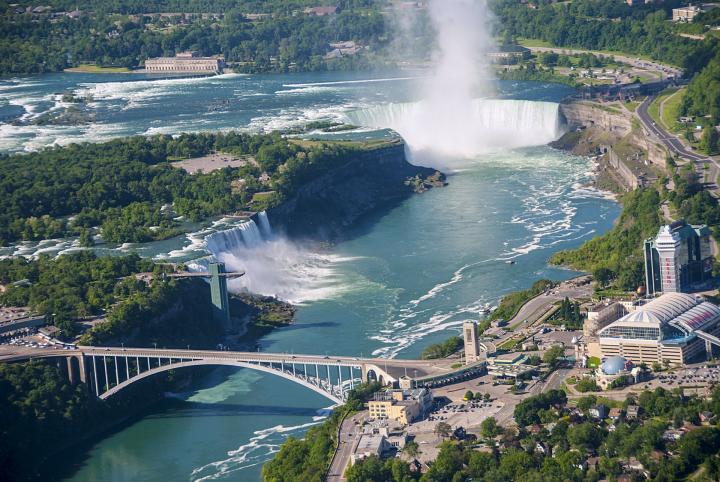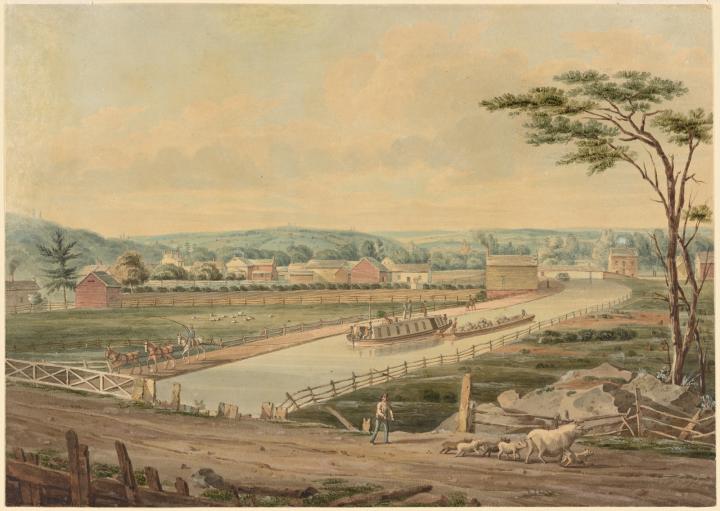Ever see Niagara Falls or the Erie Canal? Join the Almanac on our coast-to-coast exploration of America’s most beloved national parks and historic sites—plus, here’s a quirky story of a woman who went down Niagara Falls (in a pickle barrel)!
Niagara Falls
Today, we headed to the Honeymoon Capital of the World: Niagara Falls!
Niagara’s reputation as a honeymoon hot spot seems to date back to 1801, when Vice President Aaron Burr’s daughter, Theodosia, and her new husband visited the falls after their wedding. But the true story of the falls begins 14,000 years ago, when the last glaciers retreated to form what are actually three distinct waterfalls: the American, Bridal Veil, and Horseshoe Falls.
Over 757,500 gallons of water per second pour over the falls, eroding their base at a rate of nearly a foot a year, depending on various hydrologic conditions. Close to 20% of the US’s fresh water supply makes its way over the falls. You’ve most likely had a sip of it!
First Barrel Ride Down Niagara Falls
We can’t talk about Niagara Falls without mentioning the quirky story of 63-year-old Annie Taylor who rode down Niagara Falls in a barrel on October 24, 1901. A school teacher living in Bay City, Michigan, Taylor decided on this daredevil adventure after her husband died in the Civil War. Looking for fame and fortune, she went over the falls in a wooden pickle barrel.
Why a barrel? Taylor was not the first person to jump down the falls; the first person was Sam Patch in October of 1929. He also took the plunge over the 175-foot Horseshoe Falls, but without any support. Taylor wore a harness and her barrel was cushioned. She went over the edge of the falls and actually reached the shore alive.
Despite her fifteen minutes of fame, Taylor never made her fortune. Unfortunately, she did inspire many copycats and not all survived (specifically the guy in a kayak in 1990 and the fellow using a jet ski in 1995!). Today, going over Niagara Falls is illegal, so don’t try this at home, kids!
 An aerial view of Niagara Falls, including the American Falls (left, foreground) and Horseshoe Falls (background).
An aerial view of Niagara Falls, including the American Falls (left, foreground) and Horseshoe Falls (background).
As early as 1882, the energy of the falls was harnessed by the Niagara Falls Hydraulic Power & Manufacturing Company. This early plant could only generate direct current and distribute it within two miles of the falls, but today, an average of 1.2 million gallons of water per second are diverted from the falls, with a potential to generate around 4.9 million kilowatts.
The views from both the American and Canadian side are breathtaking, though for the best view of all three falls, we recommend paying the Canadian side a visit. However you decide to see them (if you can’t make it in person, there’s even a live webcam), they are well worth the visit.
Travel Tip: Spring for the Maid of the Mist boat trip under the falls. It’s a safer way to cool off on a hot day than going over them in a barrel!
Visit the Niagara Falls State Park website for more information on visiting the falls!
The Erie Canal
The Erie Canal is America’s most famous man-made waterway. It was the Internet of its day with its large system of canals.
First conceived in the 1780s by George Washington, the Erie Canal was constructed between 1817 and 1825. It eventually spanning 524 miles from Albany to Buffalo, New York, it cost $140 billion in today’s dollars—all of it paid for by New York State, whose governor, DeWitt Clinton, pushed the project relentlessly.
What came to be called “Clinton’s Ditch,” the Erie Canal transported settlers and finished goods west to the Great Lakes and beyond, and farm products and raw materials east.
It helped create New York City, giving it an insurmountable edge over mercantile rivals like Boston and Philadelphia.
 “View on the Erie Canal”; 1829. Painting by John William Hill. Image courtesy of the New York Public Library.
“View on the Erie Canal”; 1829. Painting by John William Hill. Image courtesy of the New York Public Library.
Today, very few commercial boats and barges use the canal, but it is still open for recreational use. Its impact on life in Central and Western New York is tangible even to this day; three out of four residents of the region live within 25 miles of the canal.
There are more than 500 miles of historic waterways and trails to explore in the area. Visit the Erie Canalway National Heritage website to learn more.
Learn More
Check out the rest of our national park and historic site articles to see where to go next!
Comments